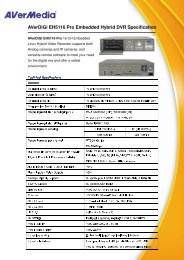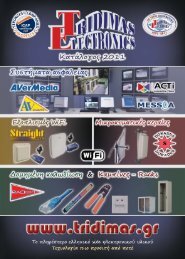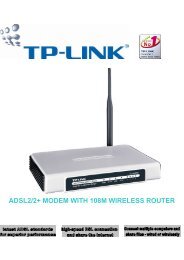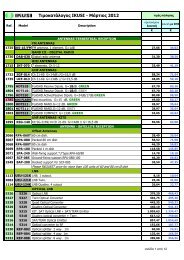ClassA - tridimas electronics
ClassA - tridimas electronics
ClassA - tridimas electronics
You also want an ePaper? Increase the reach of your titles
YUMPU automatically turns print PDFs into web optimized ePapers that Google loves.
AM<strong>ClassA</strong>SRC HEADEND• Reception of encrypted Sat-TV programs.Standard DVB-S / MPEG-2 (EN 300 421).• Receiving Modules with Common Interface(EN 50221). The encrypted TV programmestransmitted on QPSK channels arede-encrypted and presented on conventionalVHF/UHF channels (any TV systemor Colour system).• An SRC headend includes:- As many SRC Receiving Modules asde-encrypted TV programmes to bedistributed. At each module, one CAM(Conditional Access Module) containingthe Operator's Smart Card must fit thefront panel slot.- One HPA Amplifier that amplifies thesum of the receivers' output TV channels.One or more CFP Power Supplies.- One or more Rack-Frames or wall-fixingBase-Plates. The base-plates can bejoined horizontally.- Usually, housing units for the baseplates.- If the headend is large, one or moreAMX-400 combiners.The SRC headends provide a TV multichannelsignal whose level is appropriate to feedthe distribution network. With an SRC installedin the headend, the end user does notrequire a Set Top Box or any additional devicesto view the de-encrypted digital TV programsbeing distributed. An extension inputat the HPA amplifier allows easy coupling ofthe wideband 47-862 MHz signal providedby another existing headend.FUCNTIONAL DESCRIPTION OF SRCRECEIVERSAn SRC receiving module withCAM+Operator's smart card inserted,carries out a complete channel processingfrom the input to the input:- tunes a QPSK Sat-IF digital channel in the950-2150 MHz band,- selects an encrypted TV programme fromthe multiplex being received, and- de-encryptes and presents it on a conventionalTV channel that is selectablethroughout the 45-862 MHz.Main features:- Central input frequency (1 MHz increments).- Input symbol rate (pasos de 0,001 MS/sincrements).- TV programme and Audio service. (Or aRadio programme. Image will be black).- Parameters of the output TV channel(video carrier frequency, TV system, coloursystem, video modulation depth, audiomodulation index, carrier level ratio, outputlevel).- Image Format. Possible conversions are16:9 to 4:3 Pan&Scan and 16:9 to 4:3Letter-Box.Present a very low broadband noise floor(< -75 dBc) that permit to use multiple modulesin the headend with little deteriorationof the CNR.Simple cabling of SRC headendsThe SRC receiving modules feature twodirectionally coupled input and output ports.Sat-IF signal can therefore be directly fedinto the input port of the first module, whichin turn passes it through the coupler tothe next and so forth. On the output side,the same procedure is repeated whichforms the channel coupling. The sum of thecombined channels is turn connected in thesame way to the drive amplifier _the HPAmodule or an external wideband amplifier_which then feeds the distribution network.For power connection, each module hastwo DC banana sockets that allow to builda +12 VDC cascade. A third banana socketis available to connect the power for theattached LNB.An external video/audio loop, which is switchedunder control sortware, is available onmodel SRC-111.Local programming is carried out eitherwith the SPI-300 unit, which is connected toeach module individually. Remote programmingmay by carried out only if the HMScontrol unit is installed in the headend.2CabecerasIKUSI · CATALOGUE 201365








